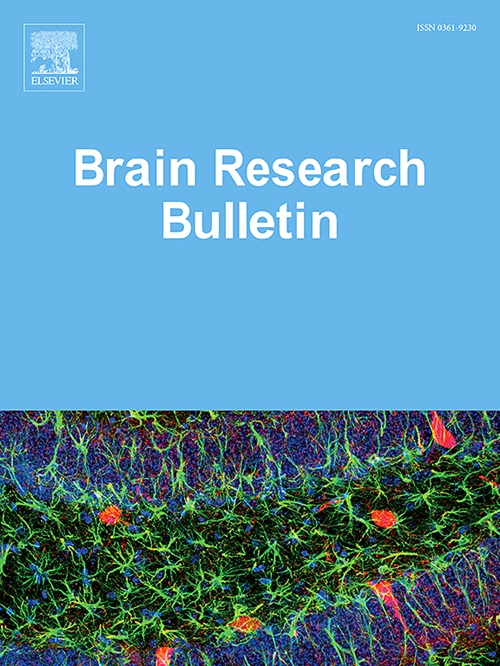Salidroside ameliorates neuroinflammation in autistic rats by inhibiting NLRP3/Caspase-1/GSDMD signal pathway
IF 3.5
3区 医学
Q2 NEUROSCIENCES
引用次数: 0
Abstract
Background
Autism spectrum disorder (ASD) is a neurodevelopmental disorder that place a huge economic and emotional burden on society. Salidroside (Sal) has been reported to have therapeutic effects in a variety of neurological disorders such as Alzheimer's disease (AD) and Parkinson's disease (PD), however no studies have been conducted to show whether salidroside is effective in ASD. Pyroptosis is involved in the pathology of a variety of neurological disorders, but has not been reported in ASD.
Objectives
The aim of this study was to investigate whether pyroptosis is involved in the pathological mechanisms of ASD, and whether salidroside has an impact on the pathological process of ASD by regulating pyroptosis.
Methods
We obtained a rat model of offspring ASD by prenatal intraperitoneal administration of valproic acid (VPA, 500 mg/kg) to pregnant rats, and we treated seven-day-old offspring ASD with salidroside (Sal, 30 mg/kg once daily) by gavage for 28 days as the salidroside treatment group. We examined the hippocampal state of ASD rats and the effect of salidroside on the hippocampus of VPA-induced ASD rats. In addition, in BV2 cells treated with LPS/Nig, we explored the mechanisms by which salidroside regulates neuroinflammation and pyroptosis in vitro.
Results
In vivo, we observed VPA-induced hippocampal neuronal damage and activation of the NLRP3/Caspase-1/GSDMD signalling pathway in ASD rats, while salidroside alleviated neuronal damage in ASD rats. In vitro, we found that salidroside inhibited LPS/Nig-induced neuroinflammation and activation of the NLRP3/Caspase-1/GSDMD signalling pathway. These results suggest that the therapeutic effect of salidroside on hippocampal damage in ASD rats may be related to NLRP3/Caspase-1/GSDMD-mediated pyroptosis.
Conclusions
Our work showed that salidroside ameliorates hippocampal neurological damage in ASD rats by targeting NLRP3/Caspase-1/GSDMD-mediated pyroptosis, providing a potential therapy drug for ASD.
水杨甙通过抑制NLRP3/Caspase-1/GSDMD信号通路缓解自闭症大鼠的神经炎症
背景:自闭症谱系障碍(ASD)是一种神经发育障碍,给社会带来巨大的经济和精神负担。据报道,苷盐(Sal)对阿尔茨海默病(AD)和帕金森病(PD)等多种神经系统疾病有治疗作用。和帕金森病(PD)等多种神经系统疾病有治疗作用,但目前还没有研究表明丹酚酸苷对 ASD 是否有效。嗜热细胞增多症与多种神经系统疾病的病理有关,但在 ASD 中尚未见报道:本研究的目的是探讨热蛋白沉积是否参与了 ASD 的病理机制,以及柳氮磺吡啶是否能通过调节热蛋白沉积对 ASD 的病理过程产生影响:方法:通过对妊娠大鼠产前腹腔注射丙戊酸(VPA,500mg/kg)获得子代ASD大鼠模型,并对7天大的子代ASD大鼠灌胃柳氮磺胺吡啶(Sal,30mg/kg,每日1次)治疗28天,作为柳氮磺胺吡啶治疗组。我们观察了ASD大鼠的海马状态以及皂苷对VPA诱导的ASD大鼠海马的影响。此外,我们还在体外用LPS/Nig处理的BV2细胞中探讨了柳氮苷调节神经炎症和热蛋白沉积的机制:在体内,我们观察到VPA诱导的ASD大鼠海马神经元损伤和NLRP3/Caspase-1/GSDMD信号通路的激活,而柳氮苷减轻了ASD大鼠的神经元损伤。在体外,我们发现柳氮磺吡啶抑制了 LPS/Nig 诱导的神经炎症和 NLRP3/Caspase-1/GSDMD 信号通路的激活。这些结果表明,柳氮磺吡啶对ASD大鼠海马损伤的治疗作用可能与NLRP3/Caspase-1/GSDMD介导的热蛋白沉积有关:我们的研究表明,水杨甙通过靶向NLRP3/Caspase-1/GSDMD介导的热蛋白沉积,改善了ASD大鼠海马神经损伤,为ASD提供了一种潜在的治疗药物。
本文章由计算机程序翻译,如有差异,请以英文原文为准。
求助全文
约1分钟内获得全文
求助全文
来源期刊

Brain Research Bulletin
医学-神经科学
CiteScore
6.90
自引率
2.60%
发文量
253
审稿时长
67 days
期刊介绍:
The Brain Research Bulletin (BRB) aims to publish novel work that advances our knowledge of molecular and cellular mechanisms that underlie neural network properties associated with behavior, cognition and other brain functions during neurodevelopment and in the adult. Although clinical research is out of the Journal''s scope, the BRB also aims to publish translation research that provides insight into biological mechanisms and processes associated with neurodegeneration mechanisms, neurological diseases and neuropsychiatric disorders. The Journal is especially interested in research using novel methodologies, such as optogenetics, multielectrode array recordings and life imaging in wild-type and genetically-modified animal models, with the goal to advance our understanding of how neurons, glia and networks function in vivo.
 求助内容:
求助内容: 应助结果提醒方式:
应助结果提醒方式:


